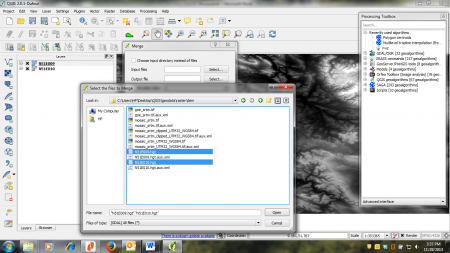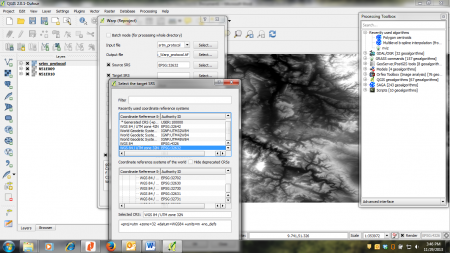Digital Elevation Model (DEM) Processing
From AWF-Wiki
(Difference between revisions)
(→Clipping and Resampling of DEM data) |
(→Clipping and Resampling of DEM data) |
||
| Line 23: | Line 23: | ||
## Select {{mitem|text=Vector --> Research tools --> Polygon from layer extent}}. Choose the landsat map as input, select an output path and file name and confirm with {{button|text=OK}}. Confirm the following prompt to let the layer be added to the canvas. | ## Select {{mitem|text=Vector --> Research tools --> Polygon from layer extent}}. Choose the landsat map as input, select an output path and file name and confirm with {{button|text=OK}}. Confirm the following prompt to let the layer be added to the canvas. | ||
# Buffer the boundary polygon | # Buffer the boundary polygon | ||
| − | # | + | #* Choose {{mitem|text=Vector --> Geoprocessing tools --> Buffer}} and select the boundary polygon created before as input. Select a reasonable name and output directory under {{button|text=Output shapefile}}. Confirm with {{button|text=OK}} and let the output layer be added to the canvas. Place it below the boundary polygon in the [[TOC]] to see the effect of buffering. |
| + | # Clip the DEM map | ||
| + | ## Open the clipping tool under {{mitem|text=Raster --> Extractions --> Clipper}}. Select the reprojected DEM file as input and select the output directory and file name as usual. Select the {{button|text=Mask layer}} radio button to select the buffered boundary layer as blueprint for clipping. | ||
[[category:QGIS exercises 2013/14]] | [[category:QGIS exercises 2013/14]] | ||
Revision as of 14:38, 21 January 2014
| sorry: |
This section is still under construction! This article was last modified on 01/21/2014. If you have comments please use the Discussion page or contribute to the article! |
- This article is part of the QGIS tutorial 2013/14.
In this article you will learn how to pre-process and enhance digital elevation model (DEM) data, as well as how to create a 3D-Model
Loading, merging and reprojection of DEM data
- Add the raster layers N51E009.hgt and N51E010.hgt to a new QGIS project (from geodata\raster\DEM, see Course data). Arrange the first above the latter layer.
- Merging layers
- Select Raster --> Miscellaneous --> Merge. In the appearing menu, click the Select beside the Input files field. Browse for the maps N51E009.hgt and N51E010.hgt and select both (by clicking with pressed Ctrl key) (figure A).
- Select an output directory and file name (e.g. N510_merged) under Output file. Confirm with OK.
- Reprojecting layers (warp)
- Select Raster --> Projections --> Warp (reprojects).
- As Input file choose the merged layer from the preceding step. Select an according path and file name for Output file.
- Determine the correct source and target spatial reference system (Source SRS and Target SRS) -- The coordinate system of the source layer is WGS84 (EPSG:4326). Use UTM32 (EPSG:32632) as target (figure B).
- Confirm with OK.
 Figure A: Merge dialogue and file browser in QGIS 2.0 |
 Figure B: Warp dialogue and menu for SRS selection in QGIS 2.0 |
Clipping and Resampling of DEM data
- Create a boundary polygon
- Add the raster map geodata/raster/landsat/landsat8/DOY156/SUB_LC81950242013156LGN00_B1 from the course data to the project.
- Select Vector --> Research tools --> Polygon from layer extent. Choose the landsat map as input, select an output path and file name and confirm with OK. Confirm the following prompt to let the layer be added to the canvas.
- Buffer the boundary polygon
- Choose Vector --> Geoprocessing tools --> Buffer and select the boundary polygon created before as input. Select a reasonable name and output directory under Output shapefile. Confirm with OK and let the output layer be added to the canvas. Place it below the boundary polygon in the TOC to see the effect of buffering.
- Clip the DEM map
- Open the clipping tool under Raster --> Extractions --> Clipper. Select the reprojected DEM file as input and select the output directory and file name as usual. Select the Mask layer radio button to select the buffered boundary layer as blueprint for clipping.